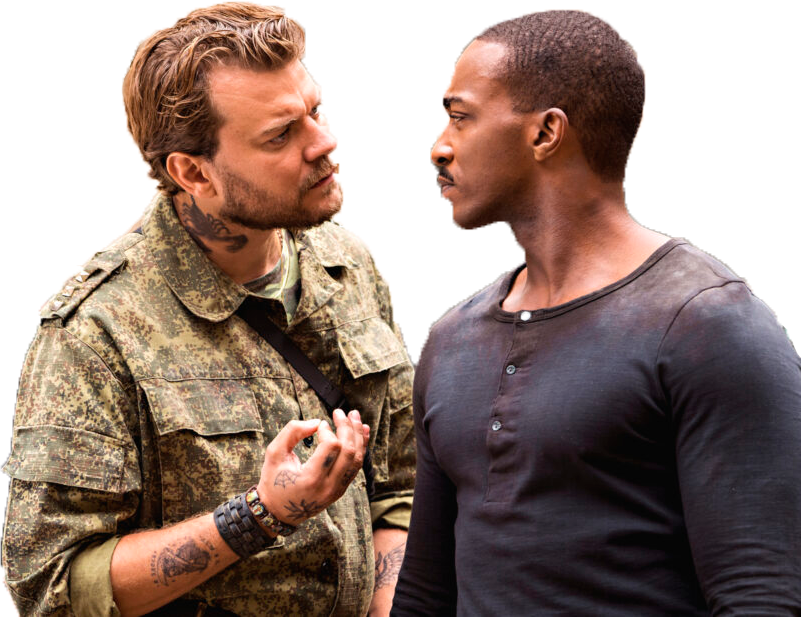Released Jan. 15, 2021, Netflix’s latest sci-fi robot war film “Outside the Wire” reinvents the wheel when it comes to following the commonly seen trope of sentience in machines, seen in robot movies such as “AXL,” “Chappie” and “Big Hero Six.” However, that’s not to say that they didn’t put their own spin on said “wheel.”
The movie begins with protagonist Lieutenant Thomas Harp eating a bag of gummy bears while piloting a military drone in Eastern Europe, overseeing a heated battle between his fellow soldiers and Russian terrorists. This opening scene is remarkably efficient in setting up both the supposed setting of the movie as well as the main character’s motivation. In a not-too-distant future with robots, the world has circled back to Cold War-like tensions, with Russia seeking to annex Ukraine, but this time America has its nose full-deep in eastern priorities. Called “Gumps” by their human counterparts, robots have seemingly been mass-produced by the United States to act as expendables in hostile conflict. Harp is a part of this tense conflict, but his demeanor is indifferent, as if his years of virtual piloting has desensitized and disconnected him from the strife. This trait is cemented and packaged with his character immediately, as he disobeys a direct order to not fire at a volatile Russian payload that two human American soldiers were using as cover, killing the young men. He is questioned later for his horrific actions, justifying them as “the call that felt most correct,” as by sacrificing the two soldiers, he saved the rest of the platoon from being blown up by the payload. Nevertheless, he is fittingly punished by being sent in-person to the very base belonging to the platoon he ‘saved.’
Not too soon after, Captain Leo is introduced. Leo has been put in charge of Harp and his punishment, and so it initially looks as if Leo will be the common “tough as nails but soft on the inside” leader archetypes of so many other war movies. Almost immediately, it is revealed that Leo is actually a robot, part of a top-secret government program “Project Leo” to create the world’s first sentient bionic supersoldiers. But here’s the catch: Leo isn’t invincible. He has been programmed to feel pain, and has a neural network so complex as to also understand and feel emotion. Through many of the movie’s interactions between Harp and Leo, it is shown that Leo is in many ways much more emotionally intelligent than Harp, making him the titular foil of Harp. In one of my favorite lines by Leo, he says “Sci-Ops… My sleeve may say US, but my face conveys calm.” He uses this perceived notion to his advantage when he is able to neutralize armed rebels from firing on his men by putting down his weapon and simply talking to them. Armed with the power of understanding fear, he is able to empathize with humans, making him an effective field soldier. And thus, the stage is set for Harp, the human who cannot feel, and Leo, the robot who can.
So by now one must think “Ah, so this is a feel-good movie! Harp will ironically learn how to be human from a robot!” Wrong. This war-drama movie is so chock-full of plot twists and theme changes that it becomes easy to lose track of its point in the middle of all the action. One thing that this movie does substantially well is fight choreography. One of the most memorable fights in this movie occurs towards the end of the first act, where Leo and Harp must infiltrate a bank to steal some nuclear launch codes. The camera perfectly centers Leo in every shot, as he quickly calculates and manipulates his surroundings for the best cover. With every gunshot he fires, the screen shakes with intensity, and with every takedown, a perceptible fast-forward gives each encounter an energetic pace. Much of the substance of these fights though comes from Leo’s atypical combat techniques that would likely be impossible for a human. He jumps through windows and precision-shoots baddies through other baddies. He throws grenades and manually detonates them by shooting them mid-backflip. Each attack leads into the next, and eventually the scuffles morph to look more like a beautiful synchronized dance. That being said, any encounters with CGI involved could definitely use some work. For example, the Gumps look astounding for the most part, but some shots of theirs appear way too glossy and smooth, as if they were scenes from a video game and not a war movie. Additionally, the movie’s use of repeated assets, such as scenes of robots jumping out of cars and military drones aiming cannons, seem like more copy-and-paste than anything.
After a memorable and touching fight sequence at the end of the movie, in a matter of minutes, Harp’s team is suddenly disabled. Personally, I found the pacing of this final act impossible to follow, and that it left me reeling with confusion and bewilderment at just how underdeveloped a conclusion to a movie with such high-grade topics can be.
“Outside the Wire” is an astonishing war film. Through trial and tribulation, the movie demonstrates the visceral nature of conflict and the dehumanizing nature it can have on the people who fight in it. The title itself is a double entendre, referring to Harp’s departure from “inside the wire,” meaning as a drone pilot, and Leo’s ascendance from his “wires” that are meant to control and weaponize him. This movie sets up so many spinning plates and high-brow socio-political statements, and yet falls short on providing a solution to most of them. Harp is depicted as having learned the error of his ways, however, Harp’s cruel, insensitive nature in this movie is never truly addressed, along with the United States’ continued destruction in eastern Europe and automation of its military. For all the cool dialogues this movie starts and the flashy ways it presents them, it fails to satisfy its viewers with its rushed conclusion and disappointing character development.


























